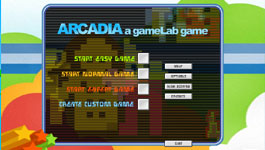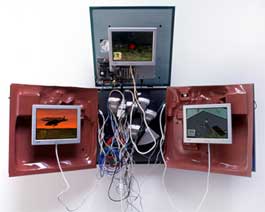Digital Play: Reloaded opens on March 18 at the Museum of the Moving Image in New York. The exhibit will festure Pac-Mondrian , Katamari Damacy and eight other innovative digital games.
Other new installations include Arcadia, an arcade-style PC game from Gamelab, which challenges audiences to play four retro-inspired video games at one time.
 Stepmania, an independently created, open-source version of the arcade dance game Dance Dance Revolution. Unlike its commercial counterpart, Stepmania incorporates audiences’ music collections and dance patterns, which are shared online.
Stepmania, an independently created, open-source version of the arcade dance game Dance Dance Revolution. Unlike its commercial counterpart, Stepmania incorporates audiences’ music collections and dance patterns, which are shared online.
Music-, dance-, and movement-oriented video games originating in Japan constitute a shift from traditional, often violent game scenarios. Classic arcade games from the 1980s are paired with current home-based games to contrast their approaches to such action-related topics as driving and waging battle on land and in space. Though the graphics have changed significantly, patterns of play remain similar.
In the lobby of the museum, Paul Johnson’s video game sculpture, Maiden Flight, shows how the habits of a “snacking couch potato” determine the fate of a far-away space station under construction. Each scenario plays out in real time without the possibility of human intervention. The work uses techniques of automation that reflect the latest innovations in commercial computer-game and simulation software.

One of Johnson’s other works, Trauma (was at the Museum last year, picture above) displays the sophistication and automation of commercial computer-game software, such as “persistent world” games, which continue to evolve when nobody is playing them, and NPCs (non-player characters), which are driven by artificial rather than human intelligence.
Two screens show self-playing video games: military combat and household simulation. Each is affected by the amount of “trauma” generated by the other. In the military game, trauma is determined by a mission’s success or failure, or by a character’s proximity to violent events. In the household simulation, trauma is determined by the need for maintenance and cleaning. The third screen is a composite of the two games; it displays the aggregate amount of trauma —the trauma index— as a red, gaseous cloud.
Via Rhizome.
